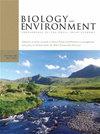斯瓦尔巴群岛陆地生态系统:北极岛屿视角下的异质性、复杂性和脆弱性
IF 0.6
4区 环境科学与生态学
Q4 ENVIRONMENTAL SCIENCES
Biology and Environment-Proceedings of the Royal Irish Academy
Pub Date : 2022-01-01
DOI:10.3318/BIOE.2005.105.3.155
引用次数: 80
摘要
摘要:斯瓦尔巴群岛是巴伦支海西北边缘的一个群岛。尽管地处极北端,但群岛西部的气候相对温和。这是由于温暖的北大西洋暖流到达最大的岛屿斯匹次卑尔根岛,导致那里的温度经常在冰点附近波动,即使在冬天也是如此。斯瓦尔巴群岛的生态系统具有一些典型的岛屿特征。然而,尽管陆地面积有限,但不同空间尺度上的生态系统之间存在很大的异质性:北极生物气候亚带中有五分之三发生在群岛,从极低生产力的极地沙漠延伸到相对生产力的苔原。本文的植物群落数据表明,在不同的生物气候亚带中,中分带(地带性)生境的植物群落有很好的分化。在一个亚带内,在两个最温暖的区域中,在中庭和脊状生境之间存在强烈的群落分化,而在最冷的极地沙漠中则没有。与“大陆”相比,斯瓦尔巴群岛的物种多样性较低,陆地食物网简单,与海洋食物网联系紧密。然而,充分考虑到食物网的无脊椎成分,揭示了相当大的复杂性,这可能有助于生态系统的稳健性。从岛屿特征的角度讨论了斯瓦尔巴群岛陆地生态系统的脆弱性。这些生态系统在草食动物种群和气候的时间变化方面是稳健的,但在人为干扰方面是脆弱的。它们在气候变化方面的脆弱性仍然是一个悬而未决的问题,需要更彻底的评估。本文章由计算机程序翻译,如有差异,请以英文原文为准。
TERRESTRIAL ECOSYSTEMS ON SVALBARD: HETEROGENEITY, COMPLEXITY AND FRAGILITY FROM AN ARCTIC ISLAND PERSPECTIVE
Abstract:Svalbard is an archipelago at the north-western edge of the Barents Sea. Despite its extreme northerly position, the climate is relatively mild in the western part of the archipelago. This is due to the warm North Atlantic Current reaching Spitsbergen, the largest island, causing temperatures there to frequently fluctuate around freezing, even in winter. Svalbard ecosystems share some attributes typical of islands. However, in spite of the limited land area there is large heterogeneity among ecosystems on different spatial scales: three out of five Arctic bioclimatic subzones occur in the archipelago, stretching from extremely low productive polar deserts to relatively productive tundra. Plant community data presented in this paper demonstrate that plant communities in mesic (zonal) habitats are well differentiated among the different bioclimatic subzones. Within a subzone, strong community differentiation occurs between mesic and ridge habitats in the two warmest zones, but not in the coldest, the polar desert. Relative to 'mainlands', species diversity is low on Svalbard and terrestrial food webs are simple, with strong links to marine food webs. However, fully accounting for the invertebrate components of the food webs reveals a considerable complexity that may contribute to ecosystem robustness. Fragility of the terrestrial ecosystems on Svalbard is discussed in terms of island characteristics. It is concluded that these ecosystems are robust in terms of temporal variation in herbivore populations and climate, but are fragile in terms of human disturbance. Their fragility in terms of climate change is still an open question that needs more thorough evaluation.
求助全文
通过发布文献求助,成功后即可免费获取论文全文。
去求助
来源期刊
CiteScore
1.10
自引率
0.00%
发文量
6
审稿时长
>36 weeks
期刊介绍:
The journal aims to offer a broad coverage of the subject area, including the following:
- biology and ecology of the Irish flora and fauna
- microbial ecology
- animal, plant and environmental physiology
- global change
- palaeoecology and palaeoclimatology
- population biology; conservation of genetic resources
- pollution and environmental quality; ecotoxicology
- environmental management
- hydrology
- land use, agriculture, soils and environment.
Submissions on other relevant topics are also welcome, and papers of a cross-disciplinary nature are particularly encouraged.

 求助内容:
求助内容: 应助结果提醒方式:
应助结果提醒方式:


